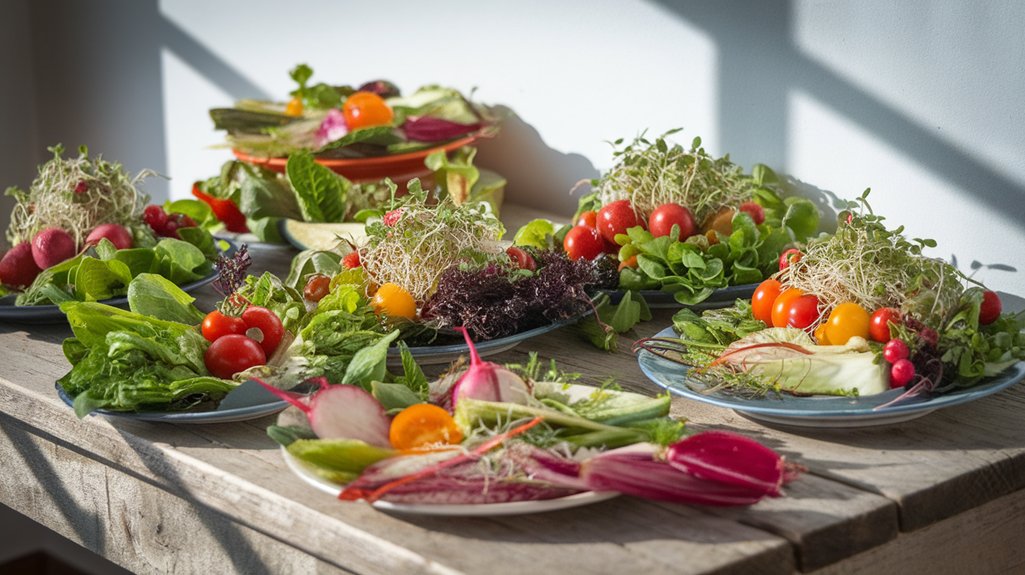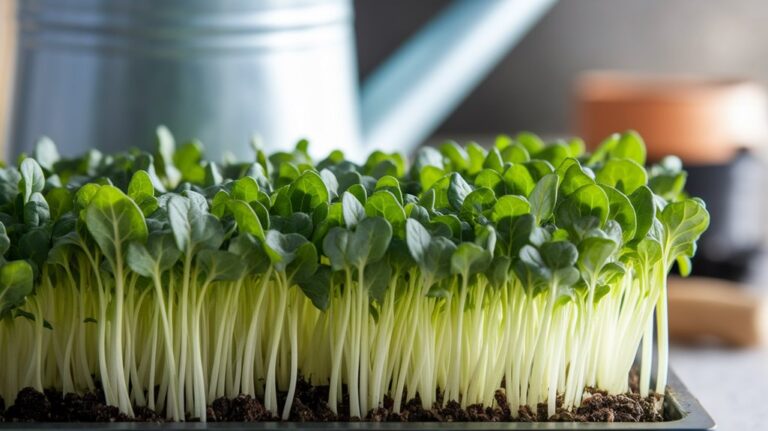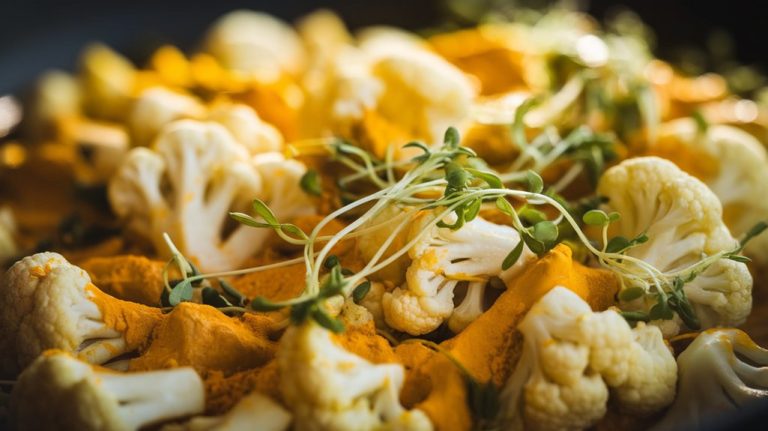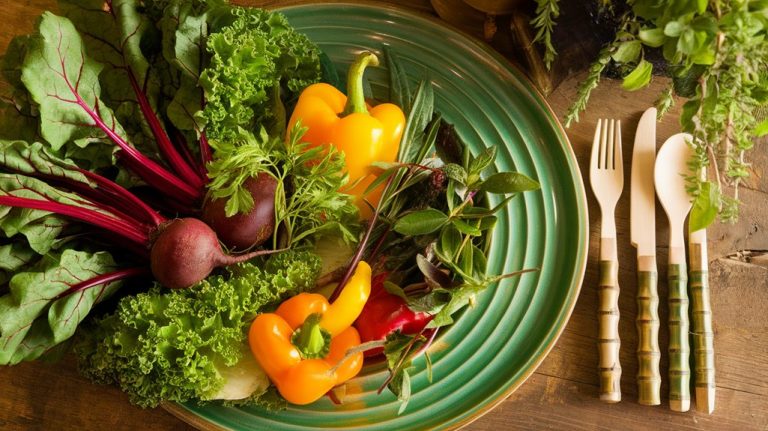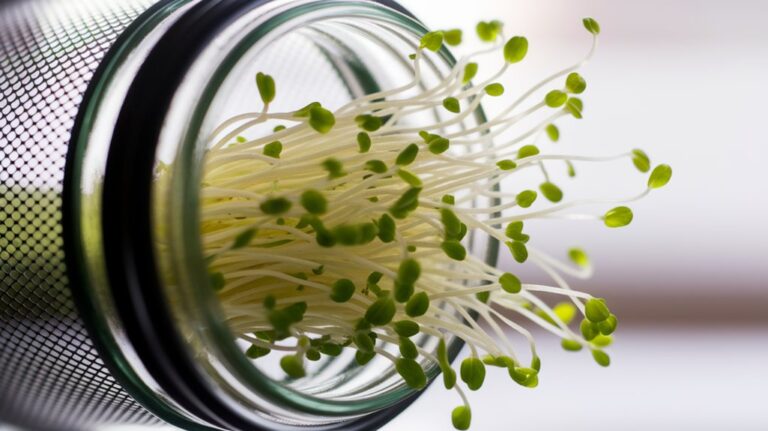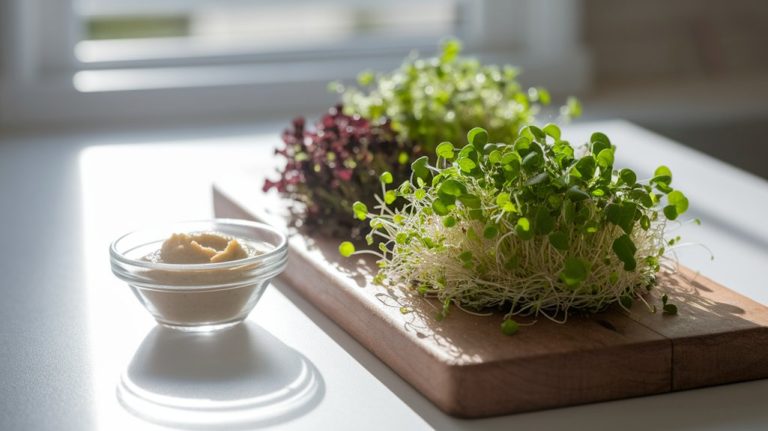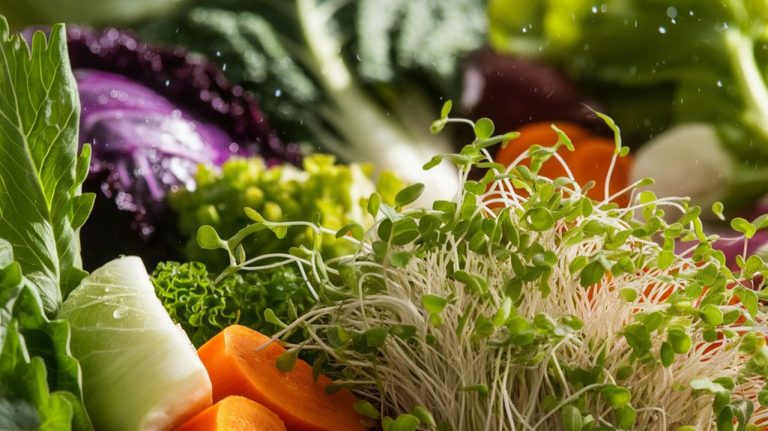Bright and Balanced Veggie and Sprout Plates
I love creating bright and balanced veggie and sprout plates because they’re packed with nutrients. By mixing colorful veggies like crisp radishes, tender greens, and vibrant carrots, I can enjoy a variety of flavors and textures. Sprouts add crunch and additional health benefits. Seasonal produce enhances my meals, and experimenting with dressings, like zesty lemon-tahini, elevates the taste. If you’re interested in maximizing your plate, you’ll discover even more great ideas to inspire your cooking.
Key Takeaways
- Incorporate a vibrant mix of colorful vegetables and nutrient-rich sprouts to create visually appealing and nutritious plates.
- Balance contrasting textures by combining crunchy elements like radishes with creamy ingredients such as avocado for added interest.
- Utilize seasonal produce to ensure freshness, higher nutrient content, and enhance the flavors of your veggie and sprout dishes.
- Experiment with homemade dressings, like lemon-tahini or chipotle-lime, to elevate the taste of your plates.
- Prepare meals in advance using mason jar salads or roasted veggie trays for quick, nutritious, and balanced options.
The Nutritional Benefits of Veggie and Sprout Plates
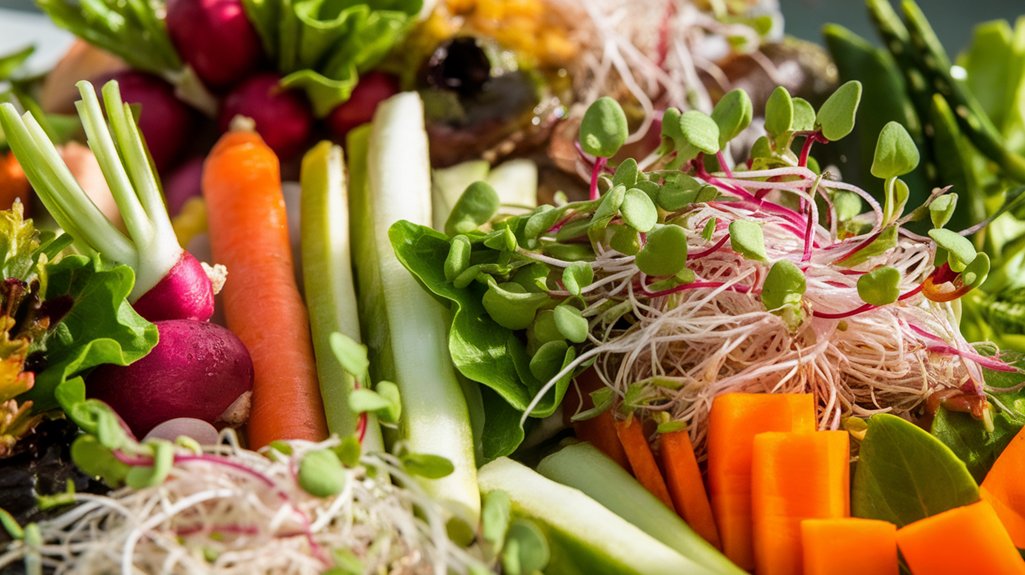
When it comes to healthful eating, veggie and sprout plates stand out as vibrant powerhouses of nutrition. I’ve found that incorporating a variety of vegetables and sprouts not only brightens my meals but also enhances my overall health.
These plates are rich in vitamins A, C, and K, essential for immune function and bone health. Additionally, the fiber content helps with digestion and keeps me feeling full longer.
Sprouts, like alfalfa and broccoli, pack a punch with antioxidants that combat oxidative stress. I’ve noticed improvements in my energy levels and skin clarity since adding them to my diet.
Essential Ingredients for a Colorful Plate
When I think about creating a colorful plate, I always start with a vibrant selection of veggies.
Incorporating nutrient-rich sprouts not only adds texture but also boosts the health benefits.
Together, these ingredients make every meal visually appealing and deliciously nutritious.
Vibrant Veggie Selection
To create a vibrant veggie selection that truly stands out on your plate, I believe it’s essential to embrace a variety of colors and textures.
Colorful vegetables not only make your meal visually appealing but also provide a range of nutrients. For instance, red bell peppers offer vitamin C, while dark leafy greens like kale are packed with iron.
I love incorporating orange carrots for their beta-carotene and purple eggplants for their antioxidants. Mixing raw, roasted, and steamed veggies adds depth and interest to each bite.
Don’t forget about the crunch factor—add some radishes or snap peas to keep things exciting.
Nutrient-Rich Sprouts
Incorporating nutrient-rich sprouts into your meals elevates not just the flavor but also the nutritional profile of your colorful plate.
These tiny powerhouses are packed with vitamins, minerals, and antioxidants that can significantly benefit your health. Take alfalfa sprouts, for example; they’re rich in vitamin K, which supports bone health, and they add a delightful crunch to salads.
Broccoli sprouts are another favorite of mine, boasting sulforaphane, a compound known for its cancer-fighting properties. I love tossing a handful of radish sprouts into my dishes for a spicy kick.
Tips for Choosing Fresh Vegetables and Sprouts
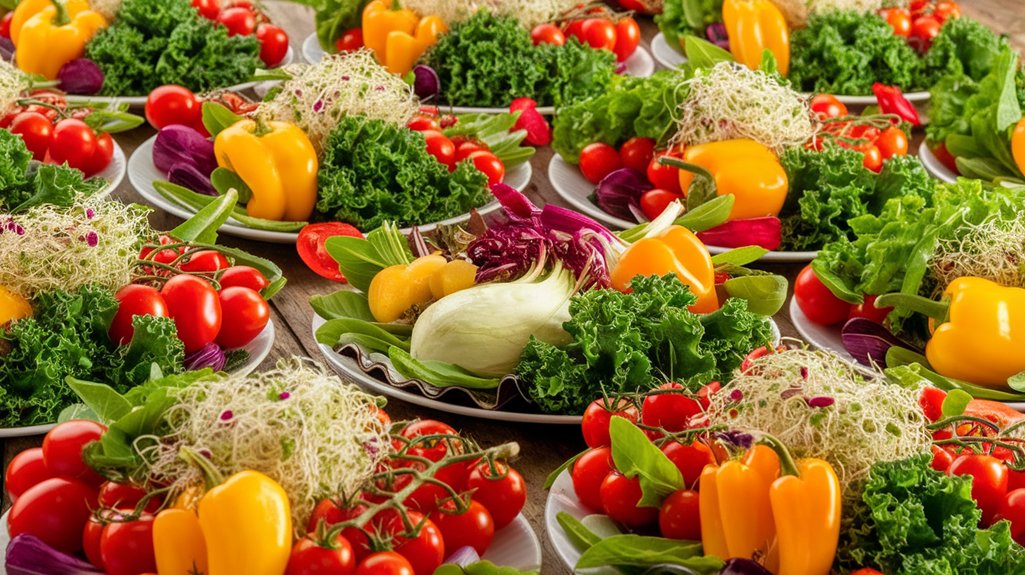
Choosing fresh vegetables and sprouts can feel overwhelming, especially with so many options available.
I’ve found that the first step is to look for vibrant colors. Bright greens, deep reds, and rich purples often indicate high nutrient content.
Next, check for firmness; fresh veggies should be crisp, not wilted or soft. If you’re buying sprouts, make sure there’s no sliminess, as that can signal spoilage.
Additionally, smell plays a role—fresh produce should have a pleasant, earthy aroma.
I also recommend buying seasonal vegetables, as they tend to be fresher and tastier.
Lastly, don’t hesitate to ask your local farmer or store staff for recommendations; they can share insights about their freshest picks.
Happy shopping!
Creative Combinations: Mixing Flavors and Textures
While experimenting with different flavors and textures can seem daunting, I’ve discovered that the key lies in balancing contrasting elements to create a satisfying dish. For instance, I love combining crunchy radishes with creamy avocado; the contrast keeps each bite interesting.
Adding sweet roasted carrots to tangy pickled onions not only enhances flavor but also adds visual appeal.
I’ve found that incorporating soft, tender greens like spinach with hearty grains such as quinoa creates a delightful textural play.
Don’t shy away from mixing raw and cooked ingredients; that’s where the magic happens! By thoughtfully pairing ingredients, you’ll create a vibrant plate that excites the palate and nourishes the body.
Dressing Your Plate: Flavorful Sauces and Seasonings
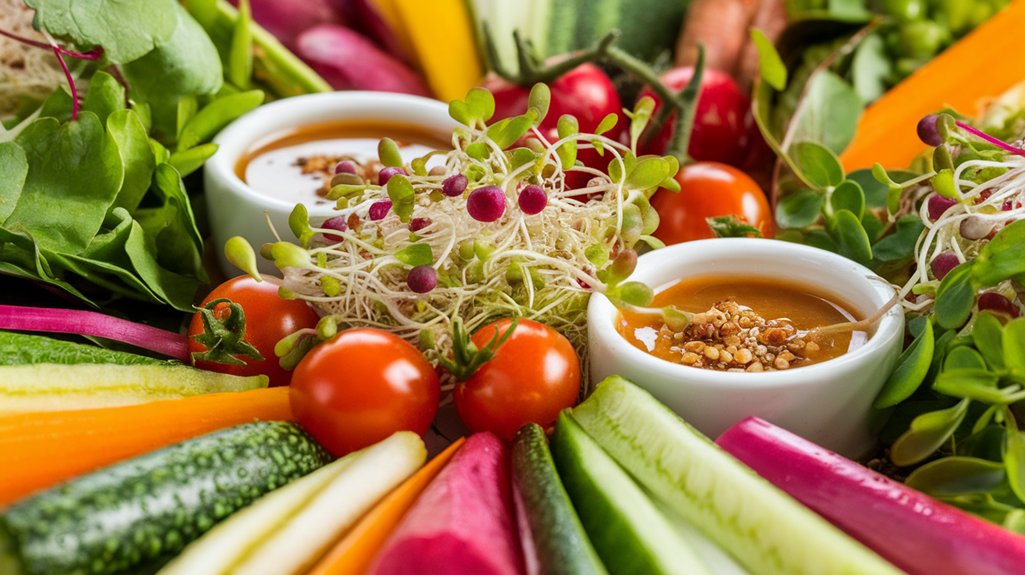
When it comes to dressing your plate, the right sauces and seasonings can elevate your veggie and sprout dishes immensely.
I love experimenting with homemade dressings, vibrant herb and spice blends, and zesty citrus combinations that bring out the natural flavors of my ingredients.
Let’s explore some ideas that can transform your meals into delicious culinary experiences!
Homemade Dressings Ideas
Homemade dressings can transform a simple veggie or sprout plate into a culinary delight, and I love experimenting with different flavors to elevate my meals. One of my go-to dressings is a zesty lemon-tahini blend; just mix tahini, fresh lemon juice, garlic, and a touch of water for a creamy consistency.
For a spicy kick, I whip up a chipotle-lime dressing using chipotle peppers, lime juice, and honey. If I’m craving something tangy, a balsamic vinaigrette made with balsamic vinegar, olive oil, and Dijon mustard never disappoints.
Each dressing not only enhances the taste but also adds nutritional benefits, like healthy fats from oils and vitamins from fresh ingredients. So, why not give these a try? Your veggie plates will thank you!
Herb and Spice Blends
In my experience, incorporating herb and spice blends can elevate the flavors of any veggie or sprout plate to new heights.
These blends not only enhance taste but also add vibrant colors and aromas that excite the senses.
Here are four of my favorite combinations:
- Italian Blend: Oregano, basil, thyme, and rosemary create a fragrant, savory experience.
- Cajun Spice: Paprika, cayenne, garlic powder, and thyme infuse dishes with a warm, zesty kick.
- Herbes de Provence: A mix of lavender, marjoram, and fennel brings a floral, aromatic touch.
- Taco Seasoning: Cumin, chili powder, garlic, and onion powder deliver a bold, comforting flavor.
Experimenting with these blends can transform simple veggie plates into delightful culinary adventures!
Zesty Citrus Combinations
Zesty citrus combinations can truly awaken the palate, adding brightness and vibrancy to any veggie or sprout plate.
I love incorporating fresh ingredients like lemon, lime, and orange juice as dressings. These fruits aren’t just flavorful; they’re rich in vitamin C and antioxidants, which boost immunity and enhance overall health.
A simple lemon vinaigrette, made with olive oil, honey, and a touch of mustard, perfectly complements roasted veggies. Or, try a lime-cilantro dressing for a refreshing kick that pairs well with sprouts.
Don’t forget about zest! Grated citrus peels can elevate flavors without adding calories.
Experimenting with these zesty combinations not only enhances taste but also keeps your plate colorful and exciting! Try them out and enjoy the burst of flavor!
Building a Balanced Meal: Grains and Proteins
While it’s easy to focus solely on vegetables when creating a healthy plate, incorporating the right grains and proteins is crucial for a balanced meal.
These components not only enhance flavor but also provide essential nutrients and energy. Here’s what I recommend:
- Quinoa – A complete protein packed with amino acids, it’s perfect for a hearty base.
- Chickpeas – Versatile and rich in fiber, they add texture and keep you satisfied.
- Brown Rice – This whole grain offers complex carbohydrates for sustained energy.
- Tofu – A fantastic plant-based protein that absorbs flavors beautifully.
Seasonal Produce: Embracing Nature’s Bounty
When I explore seasonal produce, I’m always amazed by the vibrant flavors and nutrients that come with each harvest. Eating seasonally means enjoying fruits and vegetables at their peak freshness, which enhances both taste and nutritional value.
For instance, spring brings crisp asparagus and tender peas, while summer showcases juicy tomatoes and sweet berries. Research shows that seasonal produce often contains higher levels of vitamins and minerals, since it’s harvested at the right time.
Plus, buying locally supports farmers and reduces our carbon footprint. I find joy in visiting farmers’ markets, where I can discover new varieties and reconnect with nature.
Embracing seasonal produce not only elevates my meals but also deepens my appreciation for the cycles of nature.
Meal Prep Ideas for Easy Veggie and Sprout Plates
As I dive into meal prepping, I discover that creating easy veggie and sprout plates not only saves time but also encourages healthy eating.
Here are four simple ideas that make meal prepping a breeze:
- Mason Jar Salads: Layer your favorite greens, veggies, and sprouts in a jar for quick grab-and-go lunches.
- Veggie Wraps: Fill whole grain wraps with hummus, sliced veggies, and sprouts for a satisfying snack.
- Roasted Veggie Trays: Spend an hour roasting seasonal vegetables, then portion them out for easy sides throughout the week.
- Sprout Toppers: Keep a variety of sprouts on hand to sprinkle over soups, salads, or grain bowls for added nutrition and crunch.
These ideas not only simplify my meals but also keep my diet colorful and nutritious!
Inspiring Recipes to Try at Home
Creating delicious meals at home doesn’t have to be complicated, especially when it comes to incorporating veggies and sprouts. One of my go-to recipes is a vibrant quinoa salad. I toss cooked quinoa with diced bell peppers, cucumbers, and a handful of alfalfa sprouts. Drizzle it with olive oil and lemon juice for a refreshing finish.
Another favorite is a stir-fry, where I sauté broccoli, bok choy, and snap peas in sesame oil, adding bean sprouts for crunch. Serve it over brown rice for a wholesome meal.
Lastly, I love making a veggie wrap using hummus, shredded carrots, and spinach, all rolled up in a whole-grain tortilla.
These recipes are easy, nutritious, and always leave me feeling satisfied!
Frequently Asked Questions
How Can I Store Leftover Veggie and Sprout Plates?
When I’ve leftover veggie and sprout plates, I make sure to store them properly to keep them fresh.
I place them in an airtight container and pop them in the fridge. If I want to maintain their crunch, I’ll separate the sprouts from the veggies.
I usually try to eat them within a couple of days, as they’re best enjoyed fresh.
Reheating them lightly can also help revive their flavors!
Are There Any Allergens Associated With Common Sprouts?
When it comes to common sprouts, I’ve learned that they can indeed pose allergen risks for some people.
Alfalfa, clover, and mung bean sprouts are known triggers for those with sensitivities. It’s crucial to watch for reactions, especially if you have a history of food allergies.
I always recommend introducing new foods gradually, so you can monitor for any adverse effects. Staying informed helps me enjoy my meals while minimizing risks.
Can I Use Frozen Vegetables for Veggie Plates?
Absolutely, you can use frozen vegetables for veggie plates! I often do because they’re convenient and just as nutritious as fresh ones.
Frozen veggies are picked at peak ripeness, then quickly frozen to lock in nutrients. I’ve found they still taste great and maintain a good texture when cooked.
Just make sure to thaw them properly and drain any excess water. It’s a quick way to enjoy a variety of colorful, healthy options!
What Kitchen Tools Do I Need for Preparing Veggie Plates?
When preparing veggie plates, I find a few essential kitchen tools make the process easier and more enjoyable. A sharp chef’s knife is crucial for chopping vegetables quickly and safely. A sturdy cutting board provides a stable surface.
I also love using a mandoline for uniform slices and a vegetable peeler for quick prep. Lastly, a large mixing bowl helps me combine everything beautifully. With these tools, I’m all set to create colorful, appetizing plates!
How Can Kids Be Encouraged to Eat More Veggies?
Getting kids to eat more veggies can be a fun challenge! I’ve found that involving them in the cooking process works wonders.
Letting them wash, chop, or even choose the vegetables can spark their interest. I also present veggies in creative ways—think colorful salads or veggie art!
Lastly, I make sure to model healthy eating myself; kids often mimic what they see. With patience and creativity, I’m confident they’ll embrace their greens!
Conclusion
Incorporating bright and balanced veggie and sprout plates into your meals not only delights the eye but also nourishes your body. By selecting fresh, seasonal ingredients and mixing vibrant flavors and textures, you can create dishes that are both satisfying and healthy. With a little creativity and some simple meal prep, you’ll find it easy to enjoy these wholesome plates regularly. So why not dive in and explore the colorful world of veggies and sprouts today?

